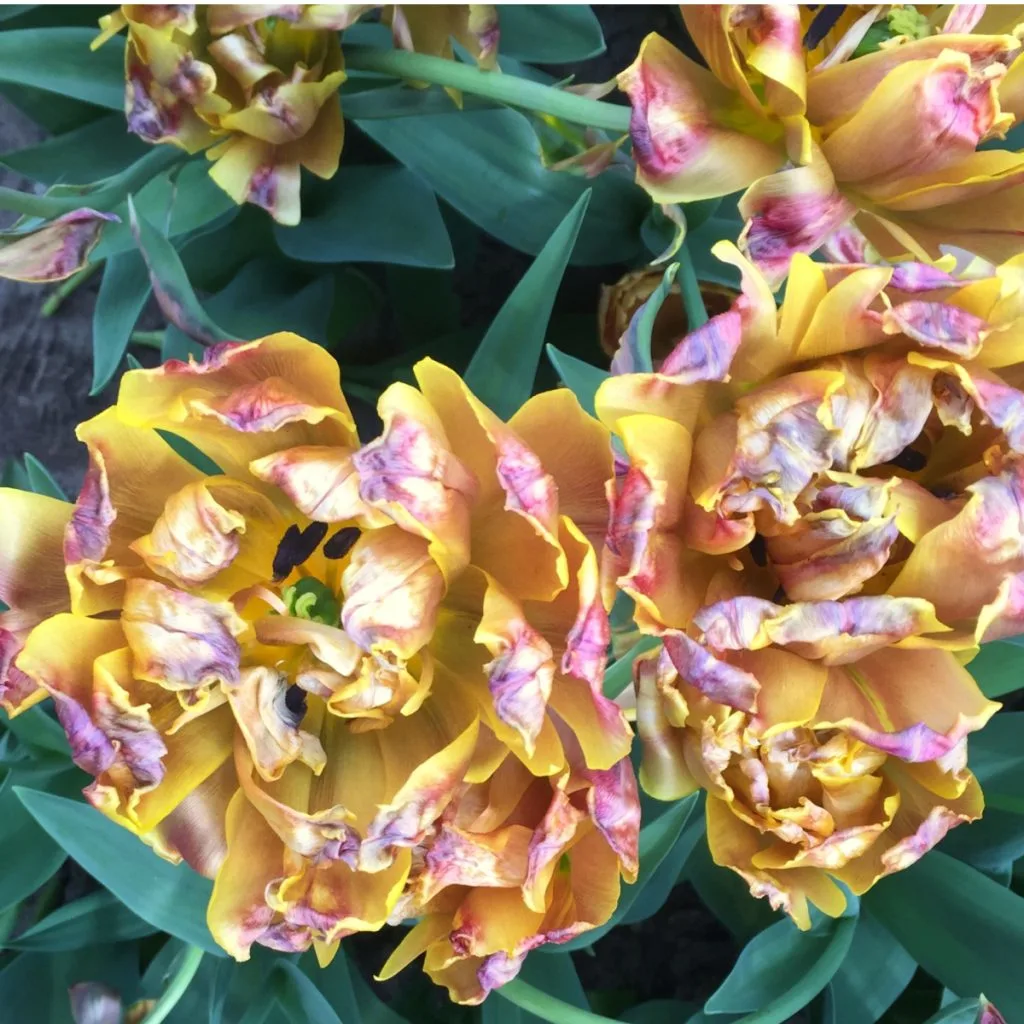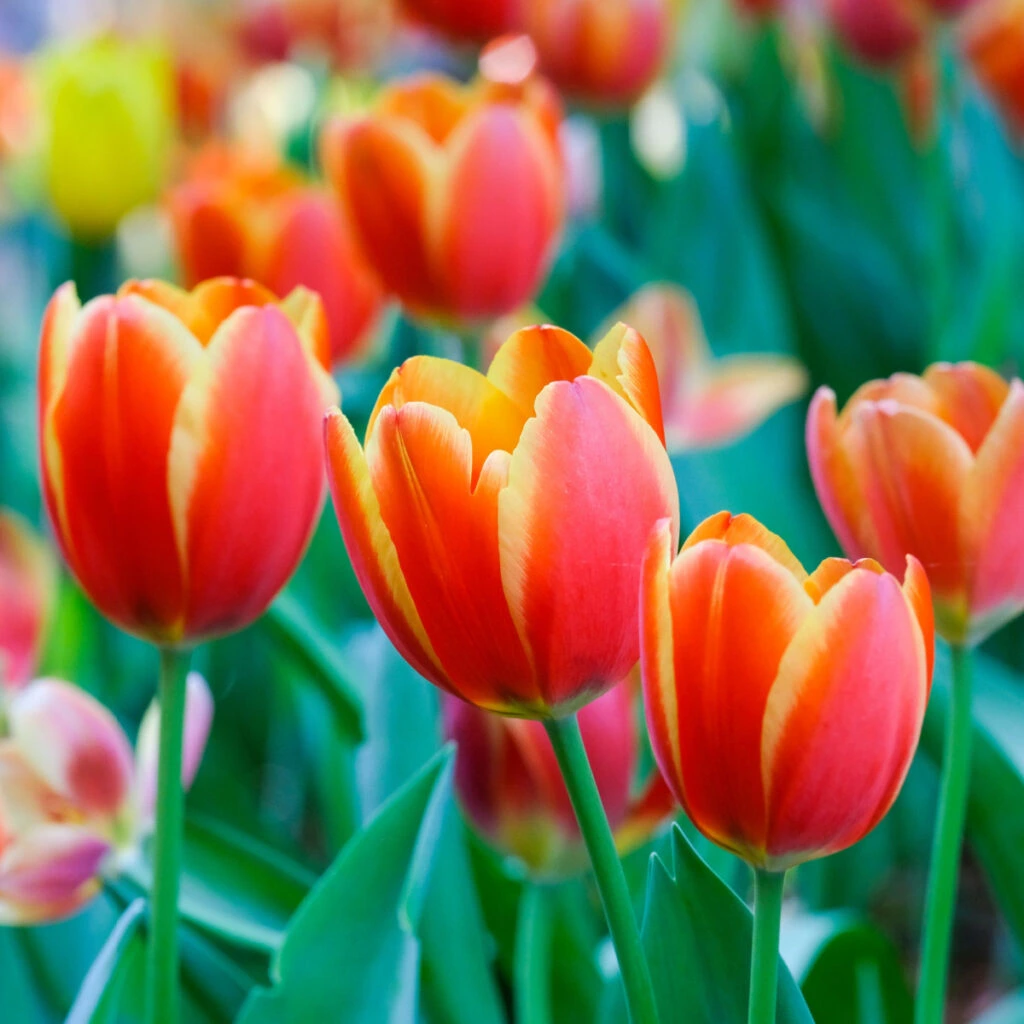Wondering what to do with your tulips this spring after they bloom? And – when it’s okay to start cutting them back?
One thing is for sure, when and how you cut your tulips back after they finish flowering is extremely important for their long-term health and survival, and in just how well they will bloom the following spring.
Tulips can sprout as early as February if the temperatures allow. And when they do, they can really bring flowerbeds to life. The gorgeous spring bulbs will often flower for a solid two to three week period – but as tulips finally start to fade away in mid to late spring, they can start to look pretty tattered – leaving many gardeners wondering if and when they can cut them back.

To keep your tulips blooming year after year, they need to be put to “bed” properly. And that includes knowing when and what to cut back. It also includes knowing when to give them a bit of fertilizer, and when it’s time to dig up and thin out your bulbs.
The good news is that all of those tasks are quite easy to do in the spring. With that in mind, let’s take a look at how to care for your tulip bulbs after they flower, and how to get them ready for even bigger blooms next year!
What To Do With Tulips After They Bloom
Removing Spent Blooms
The first order of business when it comes to late spring tulip care is to remove the flower as soon as it begins to die off. Not the entire stem – just the flower. Although it can be tempting to allow the bloom head to remain, it can actually hurt the following year’s blooms if you do.
Allowing the spent flower of a tulip to remain with the foliage will force the plant to form seed heads. Unfortunately, when the plant produces seed heads, it actually robs precious energy from the bulbs in the soil to help in the production of the seeds.
The bad news is that when the roots use all of that energy, they can’t readily or easily get it back. The result? The bulbs will have less power the following year, which most likely will mean fewer bright and beautiful blooms.

The more quickly you remove dying or fading blooms the better. As soon as the flowers begin to fade or show signs of aging, take a sharp pair of garden scissors or hand pruners and snip the bloom off about one inch below the bottom of the flower.
Avoiding Cutting Tulips Back To The Ground Too Early After They Bloom
One thing you don’t want to do is cut the flower and foliage all the way back to the ground. In fact, it’s important to try to leave as much of the remaining stem and foliage in place when cutting off spent flowers. Unfortunately, if you cut it completely back, it can have quite the negative impact on the following year’s blooms.
The stems and foliage of tulips provide power back to the bulb as they die off. Unlike the bloom head which uses nutrients, this part of the tulip gives back nutrients to the roots below as it decays. By cutting your tulips all the way to the ground early, it robs the bulbs of this valuable source of energy.
Instead of cutting the foliage and stems back, allow them to stay for a few weeks. Slowly, the remaining foliage will die back and slowly turn a yellowish / brown color. This process usually only takes ten to fourteen days, but it is vital to allow the decaying to occur. Once it does, you can then safely cut the tulips completely back to the ground.

Digging Up Old Tulips & Dividing After They Bloom
After a few years in the same soil, it’s also important to dig up bulbs and divide them to keep them strong. A good rule of thumb is to dig bulbs up every three to five years. As for when to do this, the best time is after they have died back and stored their energy.
You can do this as you cut back the decaying foliage in late spring, or in the early fall. The important part is to not dig them up in early spring before they can have time to resupply the energy to their bulbs. See our article: The Best Time To Plant Tulip Bulbs In The Fall
When digging and dividing, save only bulbs that are firm and strong. If bulbs look pale or feel soft, discard them. They simply won’t have the energy or life to overwinter and bloom next year.
Fertilizing Tulips For Success
Last but not least, it’s also vital to give your tulips an annual dose of energy. In addition to storing up power from the old foliage, tulips also benefit greatly from fertilizing. Once again, timing is everything when it comes to fertilizing for best results. And for this, it’s best to avoid powering your bulbs in spring.
For tulips, early fall is actually the ideal time to fertilize the soil where the bulbs are growing. If using a commercial fertilizer, select an all-purpose, balanced granular fertilizer that is designed for flowering bulbs. Affiliate Product link : Jobes Organics Bulb Granular Fertilizer
Be careful to work the fertilizer into only the top layer of soil, and not directly near the bulb. Fertilizer applied directly to the bulbs can burn both the bulbs and roots. Fall is best as it feeds the bulbs before winter and gives them more energy to store.
As an alternative, you can also simply put a few inches of compost on top of the soil where your bulbs are planted. As the compost breaks down, the nutrients will leach down to the bulbs. This too will help them store energy for the following spring’s blooms.
Here is to knowing when to cut your tulips back after they bloom. And even more – to even bigger and better blooms next spring!
This Is My Garden
Follow Our Facebook Page For Great Gardening Tips And Advice! This Is My Garden Facebook Page
This Is My Garden is a garden website created by gardeners, for gardeners. Jim and Mary Competti have been writing gardening, DIY and recipe articles and books and speaking for over 15 years from their 46 acre Ohio farm. They publish three articles every week, 52 weeks a year. Sign up today to follow via email, or follow along!

